Beastmaster Chess
by Glenn Overby
Introduction
Beastmaster Chess is a large chess variant with a fantasy theme. It was designed as an entry for The Chess Variant Pages, in their 7th anniversary contest for games played on a board of 84 spaces. (My other competing entry is Orwell Chess.)
This game emphasizes leaping pieces. The five beasts and the Beastmaster all have one or more leaping moves, somewhat like Knights in orthodox chess.
Setup
Beastmaster Chess board and pieces at start
(Most piece pictures from David Howe's
Alfaerie font, used by permission.
Size manipulations by Glenn Overby.)
Pieces
The Pure Leapers
Wyvern
The Wyvern (symbol W) has three leaping moves. It can move to a space three spaces away horizontally and three vertically, or two spaces one way and four the other, or five spaces one way and one the other. (The sum of the two numbers equals six.) Just like the orthodox knight, it ignores other pieces in its way. Each player has two Wyverns. White: b1, f1. Black: b8, f8.
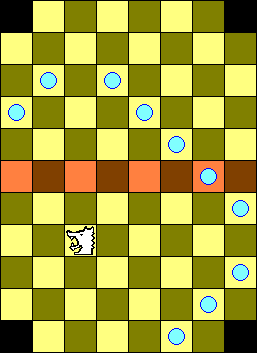
Wyverns, like orthodox bishops, are color-bound, always moving on squares of a single color (light squares in this game).
Pegasus
The Pegasus (symbol P) has two leaping moves. It can move to a space three spaces away horizontally and two vertically (or the reverse), or four spaces one way and one the other. (The sum of the two numbers equals five; this move combines the Giraffe and the Zebra.) It ignores other pieces in its way. Each player has two Pegasi. White: c1, g1. Black: c8, g8.
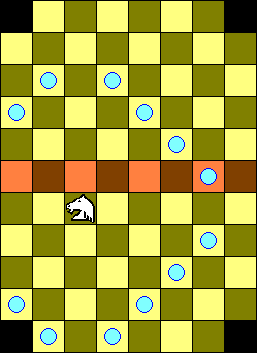
Pegasi, like orthodox knights, always move to squares of the opposite color from the square they occupy.
Roc
The Roc (symbol R) has two leaping moves. It can move to a space two spaces away horizontally and two vertically, or three spaces one way and one the other. (The sum of the two numbers equals four; this move combines the Alfil and the Camel.) It ignores other pieces in its way. Each player has two Rocs. White: d2, f2. Black: d10, f10.
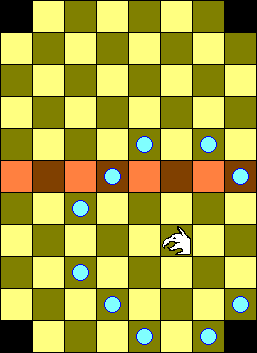
Rocs, like Wyverns, are color-bound (to dark squares in this game).
Horse
The Horse (symbol H) has the move of an orthodox knight, one space vertically and two horizontally (or the reverse), ignoring other pieces in its way. (The sum of the two numbers equals three.). Each player has two Horses. White: c3, e3. Black: c9, e9.
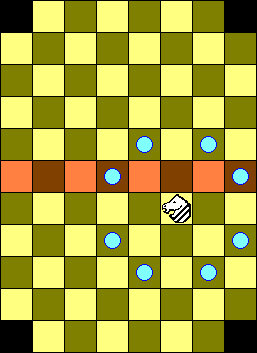
Horses, like Pegasi, always move to a square of the opposite color from the square they occupy.
The Hybrid Leapers
Lion
The Lion (symbol L) has both regular and capturing moves. It can leap two squares horizontally, vertically, or diagonally, ignoring anything in its path. It can also capture by moving one space in any direction (like an orthodox king). But the Lion cannot move only one space without capturing. White: d1. Black: d11.
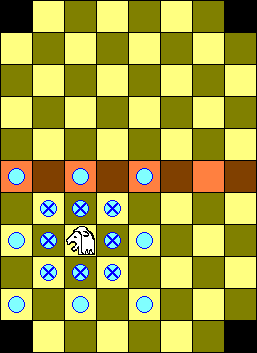
This version of the Lion is sometimes called a Murray Lion. It originates in a mistake made by H.J.R. Murray in his seminal History of Chess, when describing the lion's move in Chu Shogi.
Beastmaster
The Beastmaster (symbol B) combines the orthodox moves of a king and a knight. White: e1. Black: e11.
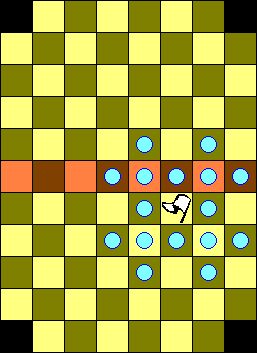
The Beastmaster is also the royal piece, like a king in orthodox chess. It may not move into check or remain in check, and checkmating the Beastmaster ends the game.
The Tribes
Tribesman
The Tribesman's (symbol T) move is similar to an orthodox pawn's. Each player has eight Tribesmen. White: a4, b4, c4, d4, e4, f4, g4, h4. Black: a8, b8, c8, d8, e8, f8, g8, h8.
A Tribesman moves exactly like an orthodox pawn, but without a double-step (or en passant captures).
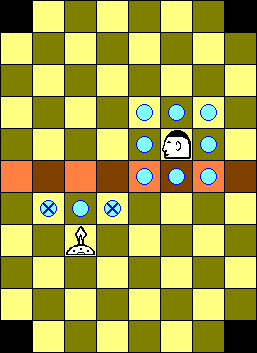
A Tribesman automatically promotes to Chief after crossing the center line to the seventh rank.
Chief
The Chief (symbol C) is a promoted Tribesman. A Chief has the move (but not the royal traits) of an orthodox king, one square in any direction. There are no Chiefs on the board at start.
Rules
Beastmaster Chess is played like orthodox chess with an odd board and pieces. The only rules differences beyond the new piece-moves are:
- Pawn double-steps, en passant captures, and castling do not exist.
- Promotion occurs on the seventh rank. All promotions are from Fighter to Chief.
- Stalemate is a loss for the player who cannot move.
- A player reduced to only their Beastmaster loses. (The bare king rule found in many historical variants.)
Notes
Design History
The first inspiration for what became Beastmaster Chess is a simple appreciation of what the ordinary knight adds to a game of orthodox chess. I'm not alone. Leaper-pieces of many different dimensions are common in both historic and modern chess variants.
A number of years ago, I learned R. Wayne Schmittberger's Wildebeest Chess. That game was consciously designed to balance leapers and riders. It used Rook, Bishop, and Queen (their combination) as riders, and Knight, Camel (1,3), and Wildebeest (a Knight/Camel combination) as the leapers.
When I was looking for a theme for another contest entry, I thought about carrying through to the other extreme, with leapers dominant. Research turned up a lot of leapers; too many for just 84 squares. So my thoughts turned to the Wildebeest, and how to combine more leaps into fewer pieces.
The four pure leapers have moves of three, four, five, and six spaces with a turn. The Lion in this form (there have been many invented Lions) covers the missing (0,2) orthogonal leap, with enough extra moves for balance. The Beastmaster makes a good leader for this lot, with a king's move as a nod to tradition and a knight's move in keeping with the leaper theme. (This matchup is sometimes known as a Centaur.)
On boards with many ranks a number of variant designers have given pawns an opening triple-step to shorten the trip. I took up instead the solution used in Shogi and Xiangqi--move the front ranks closer together, and increase the promotion zone. It's also a small homage to Grande Acedrex in the 1283 Alfonso X book of games, which is another game filled with beasts of myth and legend that starts its pawns farther forward.
Acknowledgements
Many thanks to Peter Aronson for helping me clarify my thinking at several stages, and to John Padavan and Zillions of Games for heavy-duty playtesting.Playing Tips
The valiant fighter is greater than a mighty dragon.
The Chief, a tribesman who has battled his way through the enemy hordes, is a formidable piece in the endgame. Any player of orthodox chess comes to understand that a king in the endgame becomes an offensive weapon. The potential of several such pieces with the same move power and without the limits about check is left as an exercise for the student.
The beasts come and go; the tribes endure.
Early play is dominated by the beasts leaping into position. But as they get exchanged away the Tribesmen and Chiefs move to center stage, helped by the short path to the promotion zone.
Computer Play
If you have Zillions of Games installed on your computer, you can play this game. Download file: beastmasterzog.zip.
Copyright © 2002 by Glenn E. Overby II. This is an entry in a contest of The Chess Variant Pages, and is used there by permission. All rights reserved.
Written by Glenn Overby II.
WWW page created: September 23, 2002.